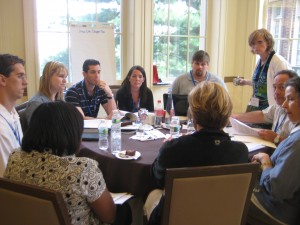Lead Your Team through the Profile, Part 2: Activity to Understand Differences
This exercise is part of a series to use as you guide your team through understanding their profile reports.
For You To Think About
When you are first introduced to a new co-worker, you may recognize a strength set and style different from our own. It’s natural to be attracted to differences, acknowledging how another’s strengths complete you. But as a relationship progresses, perspectives change. Often the traits you initially valued as strengths become the very things that you soon judge as weaknesses.
The Law of Differences holds that there are just two paths we can take as we observe others’ differences.
- We can value another’s individual differences (focus on strengths)
- We can judge another’s individual differences (focus on weaknesses)
These two pathways have different, even opposite outcomes. When we judge, we tend to see another’s differences as weaknesses. When you value another’s differences, we see the strengths that God gave them. Valuing differences leads toward relational unity and oneness on your team.
For You To Do
The exercise will help your team members understand the Law of Differences and apply it to unite the team. Often people are unaware that they judge others. As members challenge their previous ideas about strengths they discover how to value others on their team and build unity.
What You Need for This Exercise
- Copies of the article, “The Law of Differences” (one for each participant)
- Each participant’s profile report
- Paper and pencils or pens for each participant
What To Do
- Distribute copies of the article, “The Law of Differences,” to each member of your team. Allow members time to read through the article.
- Explain that the Law of Differences holds that God created each person with a unique (different) set of strengths and then purposely placed us in relationships. Ask team members to discuss the Law of Differences in light of what they discussed in the opening devotional, based on the word picture of the human body in 1 Corinthians 12.
- Have each participant turn in their profile reports to page 5 and view the Strengths Chart. Ask them to share with the group where they plot on the Problem Solving continuum.
- Lead your team through a discussion about how people truly view differences.
Have participants consider how they judge the opposite approach to problem-solving and record their responses on a sheet of paper.
Once participants are finished, lead a discussion about the thought process that typically drives how people view differences. How can judging another’s response to solving problems, for instance, create conflict and division on a team?
- Lead your team through an activity in processing differences.
Ask participants to flip over their papers. Have participants consider the strengths associated with the opposite side of the problem-solving continuum to theirs. How might the opposite strengths protect them? How might the opposite strengths complete them if embraced? Invite participants to share their ideas.
Once they are finished, lead a discussion about the thought process that embraces differences. How can valuing another’s response to solving problems, for instance, create closeness and unity on a team?
- Summarize. Ask participants to share one thing they learned about differences during this activity.
For You To Take Away
Now you are the body of Christ, and each one of you is a part of it. (1 Corinthians 12:27, NIV)
More Exercises to Help You Use the Profiles
Your Team Through the Profile, Part 1: Group Devotional
Lead Your Team Through the Profile, Part 3: Understand Your Team Members’ Differences
Lead Your Team Through the Profile, Part 4: What Value Do You Bring to Your Team?
Lead Your Team Through the Profile, Part 5: Checklist for Communicating

